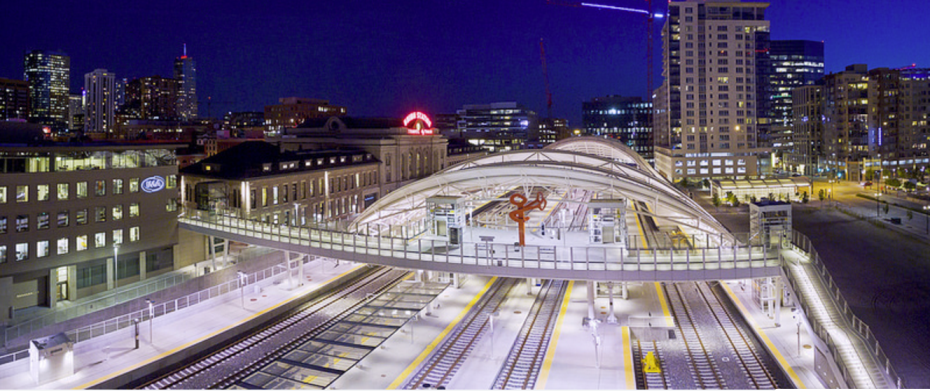A decade ago, travelers arriving at Denver, Colorado’s sprawling new airport would look out over a vast expanse of flat, prairie dog-inhabited grassland and wonder if their plane had somehow fallen short of its destination.
The $4.9 billion airport—at 53 square miles, larger than Manhattan—was derided as being “halfway to Kansas,” and given the emptiness of the 23-mile drive to the city, it felt that way.
In April of 2016, arriving airport visitors boarded the first trains headed for downtown, a journey that zips past a new Japanese-style “smart city” emerging from the prairie. It deposits passengers 37 minutes later in a bustling urban hive of restaurants, shops and residential towers that only six years ago was a gravelly no man’s land. An entire $2 billion downtown neighborhood has mushroomed-up around the hub of Denver’s rapidly expanding light rail system.
The 22.8-mile spur from the airport to downtown is the latest addition to a regional rail system that has transformed Denver and its suburbs. Using an unprecedented public-private partnership that combines private funding, local tax dollars, and federal grants, Denver has done something no other major metro area has accomplished in the past decade, though a number of cities have tried.
At a moment when aging mass transit systems in several major cities (such as Washington, DC) are capturing headlines for mismanagement, chronic delays, and even deaths, Denver is unveiling a shiny new and widely praised network: 68 stations along 10 different spurs, covering 98 miles, with another 15 miles still to come.
Even before the new lines opened, 77,000 people were riding light rail each day, making it the eighth-largest system in the country even though Denver is not in the top 20 cities for population. The effects on the region’s quality of life have been measurable and also surprising, even to the project’s most committed advocates.
Originally intended to unclog congested highways and defeat a stubborn brown smog that was as unhealthy as it was ugly, the new rail system has proven that its greatest value is the remarkable changes in land use its stations have prompted, from revitalizing moribund neighborhoods, like the area around Union Station, to creating new communities where once there was only sprawl or buffalo grass.
“We are talking about a culture-transforming moment,” says Denver mayor Michael Hancock. “Light rail has really moved Denver into the 21st century. Our adolescence is over, and we’ve matured to adulthood,”.
The RTD (Regional Transportation District) FasTracks Program is a multi-billion dollar comprehensive transit system comprising 122 miles of new commuter rail and light rail, 18 miles of bus rapid transit, 21,000 new parking spaces at light rail and bus stations, and enhance bus service for easy, convenient bus/rail connections across the eight-county district. FasTracks provides many ways to ride a bus or train:
- Drive to a Park-n-Ride and get on a bus or train
- Take a bus to a rail station
- Walk to a bus or rail station
- Ride your bike to transit stations and store your bike in lockers and racks or take it with you on buses and train
How the $7.6 billion FasTracks project saved Denver from a dreaded fate locals call “Houstonization” is the story of regional cooperation that required the buy-in of businesspeople, elected officials, civil servants and environmentalists across a region the size of Delaware.
Photo of downtown Denver station courtesy Fastraks.

